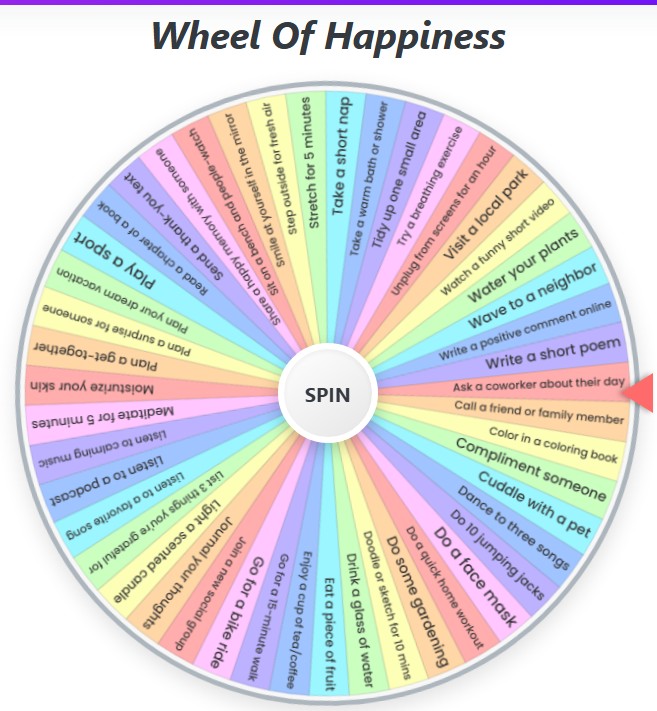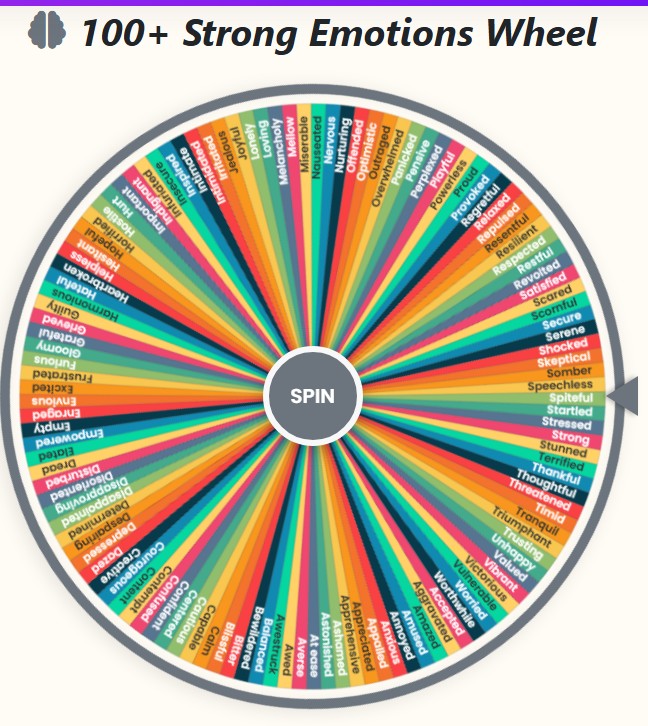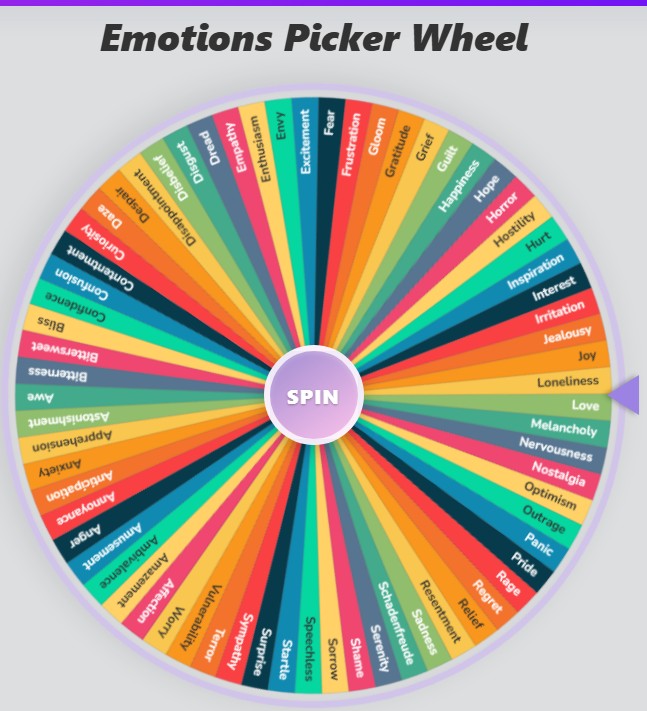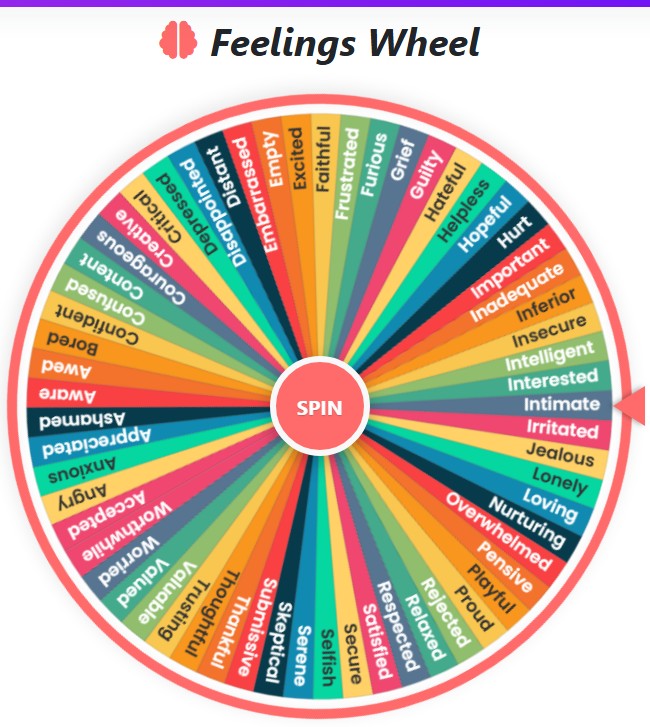Angry Emotions Wheel
Current Mode: None
Quick Link:
- Sad emotion wheel
- Positive Emotions Wheel
- Team Picker Wheel
- 60 Feelings Picker Wheel – Spin & Discover
- 70 Emotion Picker Wheel – Spin & Discover Feelings
The Ultimate Angry Emotions Wheel: Spin to Understand Your Feelings
Anger. It’s a powerful, often overwhelming emotion that we all experience. But what if that flash of red you feel isn’t just “anger”? What if it’s a signpost pointing to something deeper? Often, anger is a primary, umbrella emotion that hides more specific feelings underneath. This is where our interactive anger wheel comes in—a dynamic tool designed to help you look beneath the surface and pinpoint exactly what you’re feeling.
Think of it as a compass for your internal emotional landscape. Instead of just saying “I’m angry,” you can spin the wheel and discover if you’re actually feeling frustrated, provoked, or withdrawn. This simple act of naming the specific emotion is the first step toward managing it effectively. Ready to explore the complex world of your feelings? Let’s begin.
Explore the Core Categories of Anger
Before you spin, get familiar with the core territories of anger. Our anger wheel emotions are grouped into distinct categories, each representing a different flavor of this complex feeling.
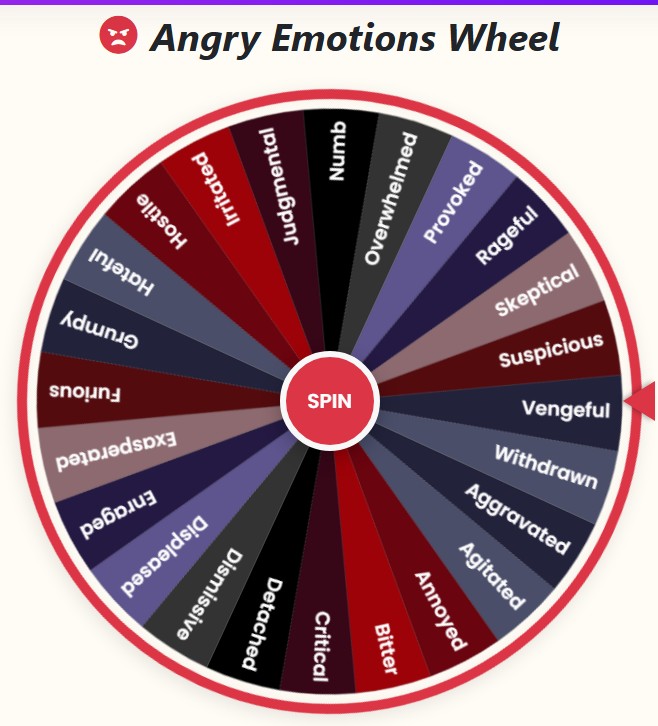
Frustrated
- Annoyed
- Irritated
- Exasperated
- Grumpy
- Overwhelmed
- Agitated
- Displeased
- Aggravated
Distant
- Withdrawn
- Numb
- Skeptical
- Critical
- Judgmental
- Dismissive
- Suspicious
- Detached
Aggressive
- Hostile
- Furious
- Enraged
- Provoked
- Hateful
- Vengeful
- Rageful
- Bitter
Why Use an Anger Wheel? 🤔
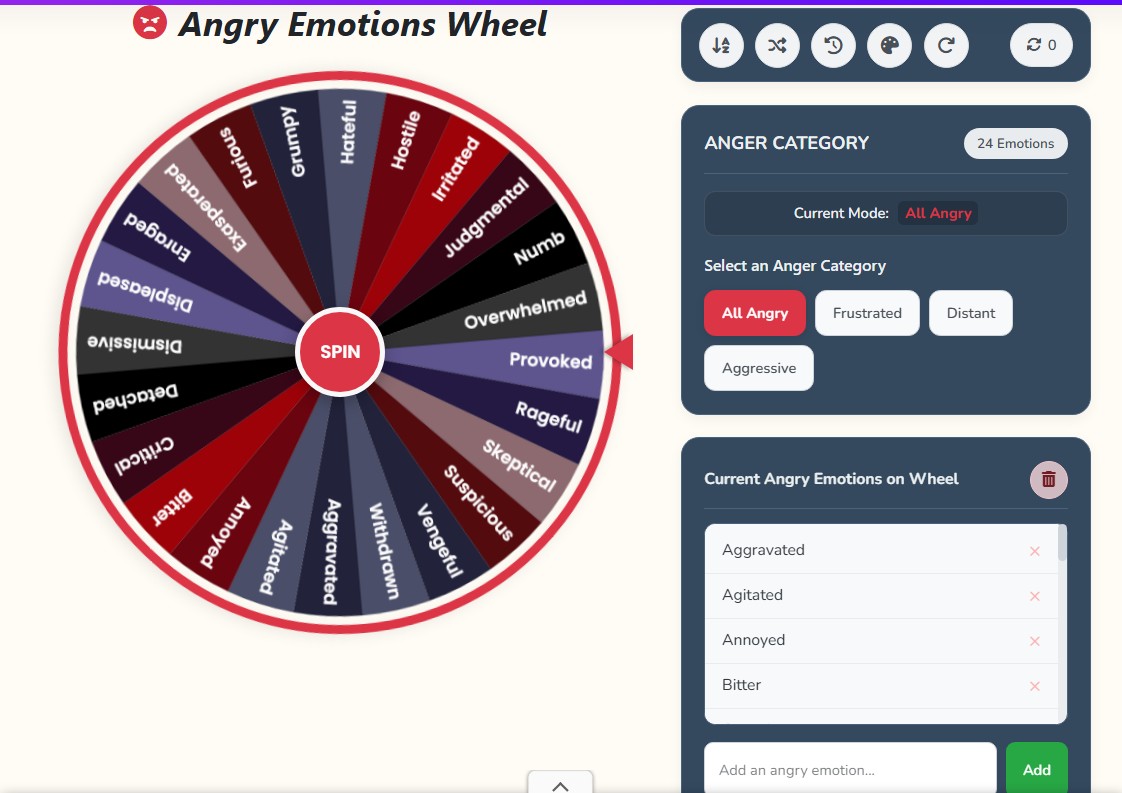
You might be wondering, “Why do I need a tool for this? I know when I’m angry.” And you’re right, you do. But knowing why you’re angry and what that anger is truly composed of is a superpower. The traditional anger model often shows us a single, fiery emotion. However, a more nuanced tool like this anger secondary emotion wheel reveals that anger is rarely that simple.
Using this wheel helps you:
Build Emotional Vocabulary: It gives you the words to describe your feelings with precision. Moving from “mad” to “exasperated” or “dismissive” is a huge leap in self-awareness.
Identify Triggers: When you start noticing a pattern—for instance, that you often land on “overwhelmed”—you can begin to identify the situations or triggers that lead to that specific feeling.
Improve Communication: It’s much more productive to tell a partner or colleague, “I’m feeling dismissed right now,” than to simply act out in anger. Specificity diffuses conflict and invites understanding.
Move from Reaction to Response: When you understand the root of your anger, you gain a crucial pause. In that moment of clarity, you can choose how to respond rather than being driven by an automatic, and often destructive, reaction.
This interactive anger wheel isn’t just a game; it’s a practical exercise in emotional intelligence.
Getting Started: A Spin of Self-Discovery 🎯
The tool is designed to be intuitive and simple. The main focus is the large, colorful wheel at the center of your screen. It’s populated with various anger wheel emotions, ready for you to explore.
The Main Event: The Spin Button
Right in the middle of the wheel, you’ll find the big “SPIN” button. This is your starting point. When you’re feeling a surge of anger but can’t quite name it, give it a click.
The wheel will whir to life with a satisfying sound, building a little bit of healthy anticipation before it lands on a specific emotion. This single action is the core of the tool—transforming a vague feeling into a concrete word.
Selecting Your Emotional Landscape
To the side of the wheel, you’ll find the control panel, starting with the most important choice: the Anger Category. This feature allows you to focus the anger wheel on a specific type of feeling you suspect you might be having.
All Angry: This is the default mode. It populates the wheel with every single emotion from all categories, giving you the broadest possible range. It’s perfect for when you have no idea where your anger is coming from.
Frustrated: Feeling stuck, blocked, or annoyed by a persistent problem? Select this category. The wheel will fill with emotions like “Irritated” and “Overwhelmed,” helping you explore feelings related to obstacles and powerlessness.
Distant: Sometimes, anger isn’t hot; it’s cold. If you find yourself pulling away, being critical, or shutting down, this category is for you. It helps you identify feelings like “Withdrawn” and “Skeptical.”
Aggressive: This is the “hot” anger we most commonly recognize. When you feel a strong urge to push back, fight, or lash out, select this category. It will focus the wheel on intense emotions like “Furious” and “Provoked.”
Choosing a category helps narrow your focus, making the tool an even more precise anger secondary emotion wheel.
Mastering the Controls for a Deeper Dive ⚙️
Beyond the main spin, a suite of powerful yet simple controls allows you to tailor the experience and dig deeper into your emotional patterns. These are found in the control panel.
Organize Your Emotions
Feeling a bit chaotic? Two buttons can help bring a sense of order:
- Sort A-Z: Clicking this button instantly arranges the emotions currently on your wheel in alphabetical order. This can be surprisingly calming and helps you scan the list logically.
- Shuffle: If you feel stuck in a rut, the Shuffle button is your friend. It randomizes the order of the emotions on the wheel, presenting them to you in a fresh, new way. This can help break mental patterns and allow an unexpected emotion to catch your eye.
Your Emotional Diary
The History button is one of the most powerful features for long-term growth. Every time you spin the wheel, the result is saved. Clicking the History button opens a log of your recent results. This isn’t just a list; it’s your emotional diary. Over time, you can review it to spot recurring feelings. Are you constantly landing on “Bitter” or “Agitated”? That’s valuable data! It’s a clear sign pointing to an area in your life that needs attention.
Personalize Your Palette
Who said exploring anger has to be drab? The Color Settings button lets you change the color palette of the wheel. Whether you prefer a dark, gothic theme or a fiery sunset palette, customizing the look and feel can make the tool more engaging and personal to you. It’s a small touch that makes the experience your own.
A Fresh Start
Sometimes you just need a clean slate. There are two ways to do this:
- Clear Wheel: This button, found above the emotion list, removes all the current emotions from the wheel, leaving it blank. This is useful when you want to build a completely custom list from scratch.
- Reset All: This is the master reset. It returns the entire tool to its original state—it selects the “All Angry” category, clears your spin history, and resets the spin counter. Use this when you want a completely fresh start.
The Customization Corner: Your Personal Anger Wheel ✨
This is where the tool transforms from a static list into a living, breathing reflection of you. The pre-loaded anger wheel emotions are a fantastic starting point, but emotional experience is deeply personal.
Adding Your Own Feelings
Beneath the list of current emotions, you’ll find an input box that says, “Add an angry emotion…” This is your gateway to full customization. Is there a specific feeling you experience that isn’t on the list? Maybe it’s a word in another language or a unique phrase that perfectly captures your feeling. Type it in, click “Add,” and it will instantly appear on the wheel. This allows you to build a truly personal anger secondary emotion wheel that speaks your emotional language.
Editing and Removing Emotions
Once an emotion is in the list, you’re still in control. You can click on any emotion in the list to edit its name. Did you make a typo? Or do you want to rephrase it? Just click, type, and click away.
Beside each emotion, you’ll see a small “×” icon. Clicking this removes the emotion from the list and the wheel. This is perfect for decluttering the wheel to focus only on the emotions that are most relevant to you right now.
Unpacking Your Spin Result: The “Aha!” Moment 💡
So you’ve spun the wheel. What now? A pop-up window appears, presenting your result in large, clear text. This is the moment of insight.
The “Aha!” Moment
The result itself is the main event. Seeing the word—”Dismissed,” “Grumpy,” “Hostile”—can be incredibly validating. It gives a name to the storm inside. Take a moment to sit with that word. Does it resonate? Does it feel true? This is the core of the exercise.
Eliminate and Focus
The pop-up gives you a powerful option: Eliminate Result. Let’s say you’re trying to figure out a complex mix of feelings. You spin the wheel and it lands on “Annoyed.” You think, “Yes, I’m definitely annoyed, but there’s more to it.” You can click “Eliminate Result.” This removes “Annoyed” from the wheel and closes the pop-up. Now you can spin again from the remaining emotions to dig even deeper. It’s a process of elimination that helps you peel back the layers of your anger.
Go Again or Close
The other options are straightforward. Spin Again closes the pop-up and immediately starts a new spin, perfect for when the first result didn’t quite hit the mark. OK simply closes the window, allowing you to reflect on your result before deciding what to do next.
Ready to Spin?
The journey to understanding anger isn’t about eliminating it; it’s about understanding it. Our anger wheel is more than just a fun online tool. It’s a bridge to self-awareness, a translator for your most difficult feelings, and a practical step toward emotional mastery. By giving names to the nuances of your anger, you take away its overwhelming power and turn it into useful information.
So next time you feel that familiar heat rising, don’t just endure it. Take a deep breath, open the anger wheel, and give it a spin. You might be surprised by what you discover.
